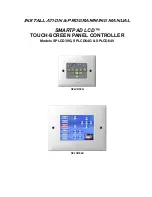
Service Modes, Error Codes, and Fault Finding
5.
5.4
Service Tools
5.4.1
ComPair
Introduction
ComPair (Computer Aided Repair) is a Service tool for Philips
Consumer Electronics products. and offers the following:
1.
ComPair helps to quickly get an understanding on how to
repair the chassis in a short and effective way.
2.
ComPair allows very detailed diagnostics and is therefore
capable of accurately indicating problem areas. No
knowledge on I
2
C or UART commands is necessary,
because ComPair takes care of this.
3.
ComPair speeds up the repair time since it can
automatically communicate with the chassis (when the uP
is working) and all repair information is directly available.
4.
ComPair features TV software up possibilities.
Specifications
ComPair consists of a Windows based fault finding program
and an interface box between PC and the (defective) product.
The ComPair II interface box is connected
to the PC
via an
USB cable. For the TV chassis, the ComPair interface box and
the TV communicate via a bi-directional cable via the service
connector(s).
The ComPair fault finding program is able to determine the
problem of the defective television, by a combination of
automatic diagnostics and an interactive question/answer
procedure.
How to Connect
This is described in the chassis fault finding database in
ComPair.
Figure 5-9 ComPair II interface connection
Caution:
It is compulsory to connect the TV to the PC as
shown in the picture above (with the ComPair interface in
between), as the ComPair interface acts as a level shifter. If
one connects the TV directly to the PC (via UART), ICs will be
blown!
How to Order
ComPair II order codes:
•
ComPair II interface: 3122 785 91020.
•
Software is available via the Philips Service web portal.
•
ComPair serial interface cable for Q54x.x.
(using 3.5 mm Mini Jack connectors): 3138 188 75051.
Note:
When having problems, please contact your local
support desk.
5.5
Error Codes
5.5.1
Introduction
The error code buffer contains all detected errors since the last
time the buffer was erased. The buffer is written from left to
right, new errors are logged at the left side, and all other errors
shift one position to the right.
When an error occurs, it is added to the list of errors, provided
the list is not full. When an error occurs and the error buffer is
full, then the new error is not added, and the error buffer stays
intact (history is maintained).
To prevent that an occasional error stays in the list forever, the
error is removed from the list after more than 50 hrs. of
operation.
When multiple errors occur (errors occurred within a short time
span), there is a high probability that there is some relation
between them.
New in this chassis is the way errors can be displayed:
There is a simple blinking LED procedure for board level repair
(home repair) so called LAYER 1 errors next to the existing
errors which are LAYER 2 errors (see
).
–
LAYER 1 errors are one digit errors
–
LAYER 2 errors are two digit errors.
•
In protection mode.
–
From consumer mode:
LAYER 1.
–
From SDM mode:
LAYER 2
.
•
Fatal errors, if I
2
C bus is blocked and the set re-boots, CSM
and SAM are not selectable.
–
From consumer mode:
LAYER 1.
–
From SDM mode:
LAYER 2
.
Important remark:
For all errors detected by MIPS which are fatal =>
rebooting of the TV set (reboot starts after LAYER 1
error blinking), one should short the solder paths at
start-up from the power OFF state by mains
interruption and not via the power button to trigger the
SDM via the hardware pins.
•
In CSM mode
–
When entering CSM: error
LAYER 1
will be displayed
by blinking LED. Only the latest error is shown.
•
In SDM mode
–
When SDM is entered via Remote Control code or the
hardware pins,
LAYER 2
is displayed via blinking LED.
•
In the ON state
–
In “Display error mode”, set with the RC commands
“mute_06250X _OK”
LAYER 2
errors are displayed via
blinking LED.
•
Error display on screen.
–
In CSM no error codes are displayed on screen.
–
In SAM the complete error list is shown.
Basically there are three kinds of errors:
•
Errors detected by the Stand-by software which lead to
protection.
These errors will always lead to protection and
an automatic start of the blinking LED LAYER 1 error.
(see section 5.6 The Blinking LED Procedure).
•
Errors detected by the Stand-by software which not
lead to protection
. In this case the front LED should blink
the involved error. See also section Extra Information. Note
that it can take up several minutes before the TV starts
blinking the error (e.g. LAYER 1 error = 2, LAYER 2
error = 15 or 53).
•
Errors detected by main software (MIPS).
In this case
the error will be logged into the error buffer and can be read
out via ComPair, via blinking LED method LAYER 1-2
error, or in case picture is visible, via SAM.
10000_0
3
6_090121.ep
s
09111
8
TO
UART
S
ERVICE
CONNECTOR
TO
UART
S
ERVICE
CONNECTOR
TO
I2C
S
ERVICE
CONNECTOR
TO TV
PC
HDMI
I
2
C only
Option
a
l power
5V DC
ComP
a
ir II Developed
b
y Philip
s
Br
u
gge
RC o
u
t
RC in
Option
a
l
S
witch
Power
Mode
Link/
Activity
I
2
C
ComP
a
ir II
M
u
lti
f
u
nction
R
S
2
3
2 /UART
Содержание 40PFL8664H/12
Страница 48: ...IC Data Sheets EN 48 Q548 1E LB 8 2009 Dec 18 ...
















































